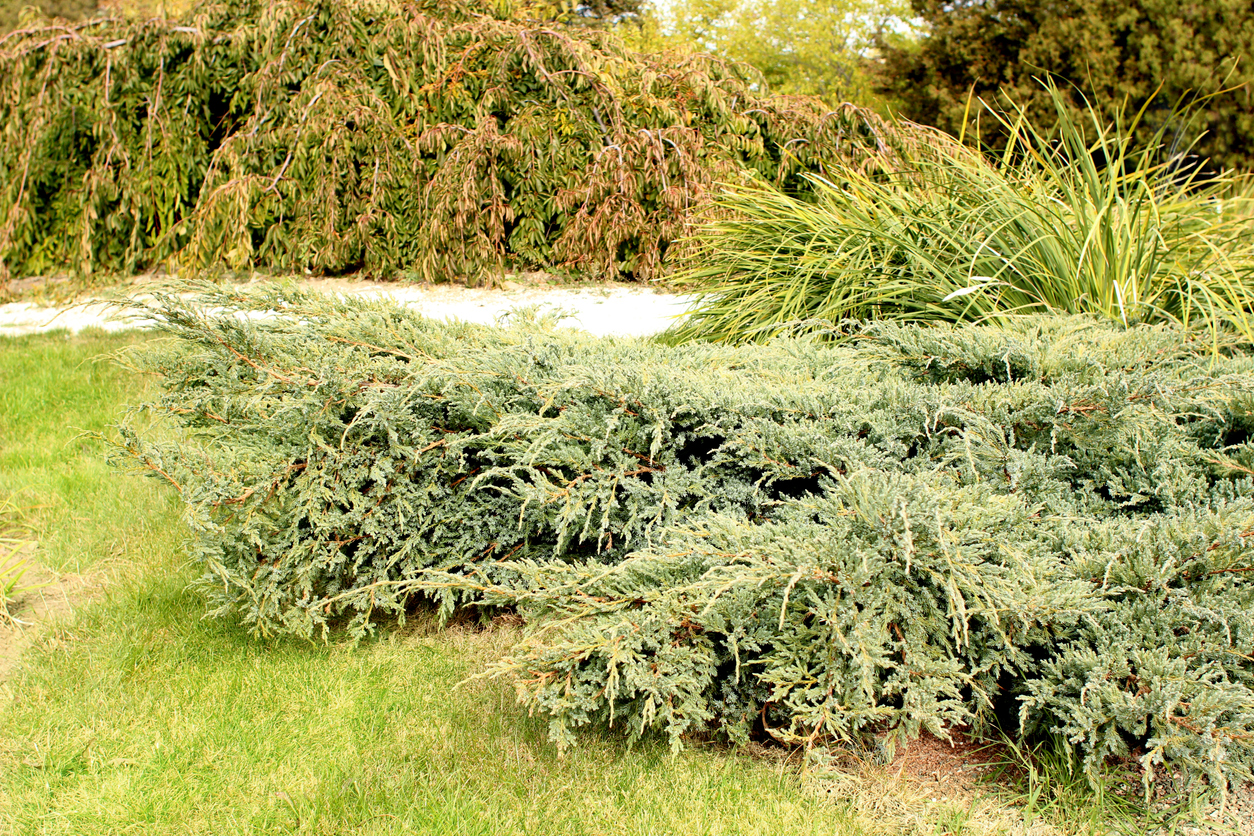We may earn revenue from the products available on this page and participate in affiliate programs. Learn More ›
Many shrubs and plants require regular pruning to keep them looking their best. Pruning removes dead or diseased branches, can improve flower or fruit production, and can improve the overall aesthetics of the plant. However, pruning can be a time-consuming process. And, if you don’t know what you’re doing, you could actually end up damaging the plant, stunting its growth, or interfering with the flowering process. Whether you’re looking for a plant that is easy to care for or just want to avoid doing more harm than good, selecting something that doesn’t require pruning can be a good choice. Read on to learn about some of the best plants to add to your outdoor landscaping that will not require much or any pruning.
RELATED: The Best Low-Maintenance Ground Cover Plants for Your Property
1. Creeping Juniper

When you’re looking for a low-maintenance plant, creeping juniper is an excellent option to consider. It is a low-growing ground cover that is very adaptable, thriving in zones 3 through 9. Pruning is not needed, but you can cut it back some if it grows too large for the space you’re trying to cover. In addition to the lack of necessary pruning, creeping juniper doesn’t require much attention in other areas, either. It can grow in several types of soil—including poor soil—without the need for any fertilizer. It is drought-tolerant and does well in a wide temperature range.
RELATED: 25 No-Effort Plants for a Foolproof Landscape
2. Gold Mop Cypress

As you may guess from its name, the gold mop cypress has golden yellow leaves. The brightness of the leaves can change based on the amount of sunlight the plant receives, with the leaves being more vibrant when the plant is grown in full sun. The shrub grows slowly, eventually becoming about 3 feet wide and 4 feet tall, requiring no pruning as it grows into its final form, which resembles an upside-down mop head. If you can’t help yourself, pruning won’t hurt the shrub and may be employed if you want to give your landscaping a more polished appearance.
RELATED: 9 of the Best Shrubs for Any Garden
3. Spotted Laurel

Spotted laurel is a type of shrub that grows in zones 7 to 10. The evergreen shrub does best in shaded or partly shaded areas and grows very slowly, making pruning a rare event. In fact, you don’t have to prune spotted laurel at all if you’ve planted it as a standalone plant. If, however, you’re using spotted laurels as a hedge, you will likely want to do some light pruning to provide a more streamlined appearance. Just take note: if you are going to prune a spotted laurel plant, you should do so in the spring after it has finished blooming. Pruning this plant in the fall could reduce the number of pretty red berries that typically cover the plant in winter.
RELATED: 15 Flowers That Attract Butterflies
4. Blue Chip Butterfly Bush

While you can prune a Blue Chip butterfly bush, doing so is not required. The plant grows spikes of purple-blue flowers that emerge in midsummer and last into October. Unlike other butterfly bushes, the Blue Chip is not an invasive species. Butterflies, bees, and hummingbirds will all be drawn to your garden if you plant it. These bushes are relatively compact, making pruning even less of a necessity. However, if you notice that your bush isn’t yielding as many flowers as you would like, a quick pruning may help the situation. The best time of the year to complete this task is in the spring, just after the first leaf buds have emerged. Use your pruning shears to trim the branches that are above the new buds.
RELATED: 15 Snake Plant Varieties for Low-Maintenance Living Decor
5. Snake Plant

Snake plants are known for a few things, one of which is their distinct appearance. The plant features long, skinny leaves that grow straight up. The leaves are green, but can have some cream, white, or yellow edging or variegation. Another thing that snake plants are known for is being easy to care for. They grow well in indirect sunlight, don’t require too much attention when it comes to watering, and do not require regular pruning. While pruning isn’t always necessary for a snake plant, it is still a good idea to check over the plant periodically and trim away any damaged or dead leaves to keep it healthy and attractive.
6. Bog Rosemary

As bog rosemary grows, it becomes denser and fills in the ground it covers. It features thin and pointy bluish-green leaves, which are accompanied by small pink flowers in the spring. Bog rosemary plants do not need to be pruned. However, they do have high water needs as they are native to wetlands. For this reason, if you’re looking for a low-maintenance plant, bog rosemary would only be a good choice if you have soil that remains moist most of the time. Bog rosemary plants are poisonous to people and animals, so keep this in mind when deciding if one will be the right fit for your yard.
RELATED: 50 Plants That Thrive in Any Yard
7. Yuki Cherry Blossom Deutzia

Yuki cherry blossom deutzia plants grow well in partial shade and full sun in zones 5 through 8. The shrubs — which are deer resistant — bloom with pretty pink flowers in the spring. In the fall, the leaves change to burgundy, allowing the plant to continue to add color to your landscaping. Pruning is not necessary with Yuki cherry blossom deutzia plants; they are compact and only grow to 2 feet tall. You may want to prune them from time to time to reshape or remove dead branches, but just make sure to wait until after the plant has finished blooming.


